Equipment
Updated April, 2012
I bought my first Digital
Camera, the Nikon Coolpix 900s, in November, 1998. It had a resolution
of 1280x960 pixels, and got me started in the world of digital
photography. Digital cameras are similar to computers in that
the technology involved progresses rapidly, so new models continue
to come out with capabilities exceeding those from just several
months back, and usually at the same or better prices. Things
have changed drastically in the past few years, and I've been
fortunate to be able to take advantage of some very exciting advances.
I went through the Coolpix series from 900s to 950 to 990, and
left the "point and shoot" world and entered the Single
Lens Reflex (SLR) a few months after the Canon D30 arrived on
the scene. The following is a summary of the gear I'm currently
using, or have used in the past:
1. Cameras
2. Lenses
3. Flash/Studio
4. Other Accessories
1.
Cameras
 After
almost 8 years of relying on my trusty Mark II, in April, 2012 I upgraded to the
Canon EOS 1D Mark IV. This camera represents a few
generations of improvements to just about all aspects of the camera: a 16.1
megapixel CMOS self-cleaning sensor with increased dynamic range, a much larger,
higher resolution LCD, much improved image quality at higher ISO, Continuous
Shooting Speed of 10 frames/second, with a buffer able to accommodate 26+ Raw
Images, HD Video capability, ability to accommodate higher speed and capacity CF
and SD cards, a new Lithium Ion battery system with superior performance, is
slightly lighter overall, with numerous other operational and performance
enhancements. Ironically, Canon is soon to come up with the 1D X, with a
full-frame sensor, a redesigned Autofocus system and other improvements.
But inexplicably they have apparently omitted the ability to use Autofocus with
a lens/teleconverter combination at f/8, which I rely on extensively.
Further, the pixel density is actually less than the Mark IV, which is a
significant disadvantage when using telephoto lenses and shooting small subjects
like birds. For these reasons, in addition to a huge step-up in price, the
Mark IV seems to meet my shooting needs better than the 1D X.
After
almost 8 years of relying on my trusty Mark II, in April, 2012 I upgraded to the
Canon EOS 1D Mark IV. This camera represents a few
generations of improvements to just about all aspects of the camera: a 16.1
megapixel CMOS self-cleaning sensor with increased dynamic range, a much larger,
higher resolution LCD, much improved image quality at higher ISO, Continuous
Shooting Speed of 10 frames/second, with a buffer able to accommodate 26+ Raw
Images, HD Video capability, ability to accommodate higher speed and capacity CF
and SD cards, a new Lithium Ion battery system with superior performance, is
slightly lighter overall, with numerous other operational and performance
enhancements. Ironically, Canon is soon to come up with the 1D X, with a
full-frame sensor, a redesigned Autofocus system and other improvements.
But inexplicably they have apparently omitted the ability to use Autofocus with
a lens/teleconverter combination at f/8, which I rely on extensively.
Further, the pixel density is actually less than the Mark IV, which is a
significant disadvantage when using telephoto lenses and shooting small subjects
like birds. For these reasons, in addition to a huge step-up in price, the
Mark IV seems to meet my shooting needs better than the 1D X.
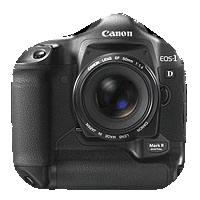 As
of May 2, 2004, I am shooting with the Canon EOS-1D Mark II.
It is based on the prior 1D, but with substantial improvements:
double the resolution (now 8.2 megapixels), it can shoot up to
20 Raw images (40 Jpeg), at 8.5 frames/second, in a single burst,
has even faster AutoFocus, an ISO range of 50-3200 with dramatically
improved image quality and very low noise at higher ISO, a significantly
improved flash system dubbed ETTL2, a brighter and higher
resolution LCD with zoom for image review, an orientation sensor
to automatically rotate vertical images, half the power consumption
resulting in double the battery life, and a number of other enhancements.
It is second in resolution only to the Canon EOS-1Ds (11.4 megapixels),
but is dramatically faster with superior high ISO performance.
For the type of photography I do, the 1D Mark II is the better
instrument, although if somebody wanted to donate a 1Ds for me
to use in addition for when speed wasn't an issue, I would be
happy to take it off their hands!
As
of May 2, 2004, I am shooting with the Canon EOS-1D Mark II.
It is based on the prior 1D, but with substantial improvements:
double the resolution (now 8.2 megapixels), it can shoot up to
20 Raw images (40 Jpeg), at 8.5 frames/second, in a single burst,
has even faster AutoFocus, an ISO range of 50-3200 with dramatically
improved image quality and very low noise at higher ISO, a significantly
improved flash system dubbed ETTL2, a brighter and higher
resolution LCD with zoom for image review, an orientation sensor
to automatically rotate vertical images, half the power consumption
resulting in double the battery life, and a number of other enhancements.
It is second in resolution only to the Canon EOS-1Ds (11.4 megapixels),
but is dramatically faster with superior high ISO performance.
For the type of photography I do, the 1D Mark II is the better
instrument, although if somebody wanted to donate a 1Ds for me
to use in addition for when speed wasn't an issue, I would be
happy to take it off their hands!
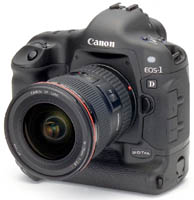 This
was Canon's top of the line digital Single Lens Reflex camera
when it was introduced: the Canon EOS-1D. It was delivered
to my doorstep on April 25, 2002. It has a 4.15 megapixel CCD
sensor, with a 1.3x "multiplier." It has Canon's most
sophisticated autofocus, metering and white balance system, has
an ISO range from 100 to 3200, shutter speeds up to 1/16,000 second,
can shoot at 8 frames/second for up to 16 or 21 frames before
its buffer is filled, offers a wide variety of custom and personal
functions to individualize its operations, connects to a computer
via a Firewire cable, and is built like a tank. For more comprehensive
information on the 1D, go to Canon's Website.
This
was Canon's top of the line digital Single Lens Reflex camera
when it was introduced: the Canon EOS-1D. It was delivered
to my doorstep on April 25, 2002. It has a 4.15 megapixel CCD
sensor, with a 1.3x "multiplier." It has Canon's most
sophisticated autofocus, metering and white balance system, has
an ISO range from 100 to 3200, shutter speeds up to 1/16,000 second,
can shoot at 8 frames/second for up to 16 or 21 frames before
its buffer is filled, offers a wide variety of custom and personal
functions to individualize its operations, connects to a computer
via a Firewire cable, and is built like a tank. For more comprehensive
information on the 1D, go to Canon's Website.
 The
introduction of the Canon D30 really changed the world
of digital photography, introducing a relatively low-cost digital
SLR with extremely high quality images. This was at least in part
attributable to its CMOS sensor (1.6x multiplier factor). It produces
3.1 megapixel images, and has an ISO range of 100 to 1600, and
shutter speeds up to 1/4000 second. It can shoot at 3 frames/second
for up to 6-8 shots. The main 'weakness' of the D30 was its autofocus
and metering systems. While these are generally quite a bit better
than any 'point and shoot' digital camera, and function well under
a wide variety of shooting circumstances, it wasn't the best that
Canon had to offer in this regard. This full potential was achieved
with the introduction of the Canon EOS-1D. For more information
on the D30, click here.
The
introduction of the Canon D30 really changed the world
of digital photography, introducing a relatively low-cost digital
SLR with extremely high quality images. This was at least in part
attributable to its CMOS sensor (1.6x multiplier factor). It produces
3.1 megapixel images, and has an ISO range of 100 to 1600, and
shutter speeds up to 1/4000 second. It can shoot at 3 frames/second
for up to 6-8 shots. The main 'weakness' of the D30 was its autofocus
and metering systems. While these are generally quite a bit better
than any 'point and shoot' digital camera, and function well under
a wide variety of shooting circumstances, it wasn't the best that
Canon had to offer in this regard. This full potential was achieved
with the introduction of the Canon EOS-1D. For more information
on the D30, click here.
Somewhat reluctantly, I
sold my D30 in May, 2002. I still include it here on my equipment
list because so many images taken with it are featured in the
various Galleries.
2.
Lenses
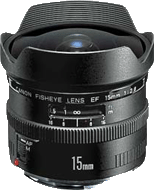 Starting
at the wide angle, this lens is the Canon 15mm/f2.8 Fisheye.
It provides a 180 degree angle of view, which creates a unique
perspective that can come in handy at times. It has a minimum
focusing distance of 8" which can create some unusual close-up
shots.
Starting
at the wide angle, this lens is the Canon 15mm/f2.8 Fisheye.
It provides a 180 degree angle of view, which creates a unique
perspective that can come in handy at times. It has a minimum
focusing distance of 8" which can create some unusual close-up
shots.
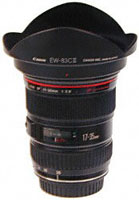 Next
is the Canon 17-35L/f2.8 zoom lens. It is shown here with
the Lens Hood attached. The L designation is for Canon's professional
line of lenses, and superior optics. The f/2.8 is a nice, constant
wide aperture throughout the zoom range, increasing shooting flexibility.
I used this lens quite a bit on my trip to Southern Utah and Northern
Arizona in May of 2001. Canon has recently come out with an updated
version of this lens, the 16-35L/f2.8.
Next
is the Canon 17-35L/f2.8 zoom lens. It is shown here with
the Lens Hood attached. The L designation is for Canon's professional
line of lenses, and superior optics. The f/2.8 is a nice, constant
wide aperture throughout the zoom range, increasing shooting flexibility.
I used this lens quite a bit on my trip to Southern Utah and Northern
Arizona in May of 2001. Canon has recently come out with an updated
version of this lens, the 16-35L/f2.8.
 This
is the Canon 50/f1.4. It's the 'fastest' lens I have, and
comes in handy when I want to shoot without flash in low light
conditions. It functions well as a portrait lens with either the
1D or D30, where their multiplier effects make this the equivalent
of a 65 mm or 80 mm lens, respectively. It is also known as a
very sharp lens, despite the fact that it's not an actual "L"
series lens.
This
is the Canon 50/f1.4. It's the 'fastest' lens I have, and
comes in handy when I want to shoot without flash in low light
conditions. It functions well as a portrait lens with either the
1D or D30, where their multiplier effects make this the equivalent
of a 65 mm or 80 mm lens, respectively. It is also known as a
very sharp lens, despite the fact that it's not an actual "L"
series lens.
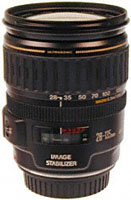 The
Canon 28-135/f3.5-5.6 IS lens is perhaps one of the best
single lens for general use with either the D30 or 1D. The focal
length covers a very wide and useful range, and while it's not
the fastest lens around, the Image Stabilization (IS) is quite
effective, giving you perhaps an extra stop or two to work with.
It is fairly small and light, and has decent macro capabilities
as well. If I'm wanting to do some casual shooting, and travel
as light as possible, this is the lens I'll take.
The
Canon 28-135/f3.5-5.6 IS lens is perhaps one of the best
single lens for general use with either the D30 or 1D. The focal
length covers a very wide and useful range, and while it's not
the fastest lens around, the Image Stabilization (IS) is quite
effective, giving you perhaps an extra stop or two to work with.
It is fairly small and light, and has decent macro capabilities
as well. If I'm wanting to do some casual shooting, and travel
as light as possible, this is the lens I'll take.
I sold this lens, along
with the D30, in May, 2002. Time will tell if I'll regret this
decision, but I replaced it with the 2 following lenses.
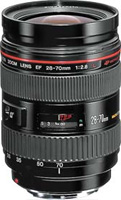 The
Canon 28-70L/f2.8 is a fast, sharp lens, covering a reasonably
wide focal range, replacing the lower half of the coverage of
the 28-135. Though significantly heavier than the 28-135, it's
still not too much to use 'casually' and I've enjoyed using it
to photograph my grandchildren around the house.
The
Canon 28-70L/f2.8 is a fast, sharp lens, covering a reasonably
wide focal range, replacing the lower half of the coverage of
the 28-135. Though significantly heavier than the 28-135, it's
still not too much to use 'casually' and I've enjoyed using it
to photograph my grandchildren around the house.
 Covering
the longer end of the range of the 28-135 is a relatively new
lens, the Canon 70-200L/f2.8 IS. This is also a fast, sharp
lens, and very useful in low-light shooting - indoors, sports,
etc. My first outing with it was photographing a High School soccer
match, and as the sun set, I was very pleased with its autofocus
capability, and the ISO and shutter speed options it provided.
The IS is quite effective, gaining 2 to possibly 3 stops. it can
be used with the 1.4x or 2x teleconverters, further extending
its usefulness.
Covering
the longer end of the range of the 28-135 is a relatively new
lens, the Canon 70-200L/f2.8 IS. This is also a fast, sharp
lens, and very useful in low-light shooting - indoors, sports,
etc. My first outing with it was photographing a High School soccer
match, and as the sun set, I was very pleased with its autofocus
capability, and the ISO and shutter speed options it provided.
The IS is quite effective, gaining 2 to possibly 3 stops. it can
be used with the 1.4x or 2x teleconverters, further extending
its usefulness.
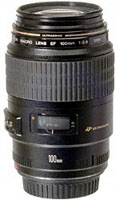 Serving
as both a high quality macro lens, and a decent lens for portrait
and other types of photography, the Canon 100/f2.8 Macro. It
is considered to be one of Canon's sharpest lenses, and its macro
capability allows up to 1:1 magnification, without requiring the
use of any other accessories. At a relatively fast f/2.8, it can
be used effectively in low-light conditions, and it can stop down
to f/32, maximizing depth of field for macro shots.
Serving
as both a high quality macro lens, and a decent lens for portrait
and other types of photography, the Canon 100/f2.8 Macro. It
is considered to be one of Canon's sharpest lenses, and its macro
capability allows up to 1:1 magnification, without requiring the
use of any other accessories. At a relatively fast f/2.8, it can
be used effectively in low-light conditions, and it can stop down
to f/32, maximizing depth of field for macro shots.
 The
Canon 100-400L/f4.5-5.6 IS, shown here with the Lens Hood
and Tripod Collar, is a fantastic telephoto lens, covering a wide
focal range, and is extremely sharp. The IS is quite effective,
and I've used this lens quite a bit for much of my nature and
wildlife shooting. At a little over 3 pounds, it's a big lens
to haul around, but it's still not too big to hand-hold effectively.
The
Canon 100-400L/f4.5-5.6 IS, shown here with the Lens Hood
and Tripod Collar, is a fantastic telephoto lens, covering a wide
focal range, and is extremely sharp. The IS is quite effective,
and I've used this lens quite a bit for much of my nature and
wildlife shooting. At a little over 3 pounds, it's a big lens
to haul around, but it's still not too big to hand-hold effectively.
 This
is the famous Canon 600L/f4 IS, one of the Canon "big
guns." Weighing in at a little under 12 pounds, it makes
the 100-400 look and feel puny. It basically requires the use
of a tripod or monopod because of its weight, but it's reach,
speed, and sharpness are incomparable. It opens up new possibilities
in bird photography, and I've been having a blast with it.
This
is the famous Canon 600L/f4 IS, one of the Canon "big
guns." Weighing in at a little under 12 pounds, it makes
the 100-400 look and feel puny. It basically requires the use
of a tripod or monopod because of its weight, but it's reach,
speed, and sharpness are incomparable. It opens up new possibilities
in bird photography, and I've been having a blast with it.
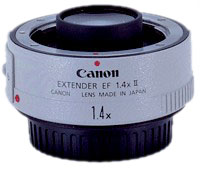 While
not a lens in its own right, the Canon 1.4x II Teleconverter
can be used to multiple the focal length of select telephoto lenses
(at the cost of 1 stop of light), but can be attached to any lens
with the use of a small extension tube. It changes the 100-400
lens to a 140-560 lens, and the 600 becomes an 840. There is a
little loss of optical quality, but this is generally fairly minimal.
While
not a lens in its own right, the Canon 1.4x II Teleconverter
can be used to multiple the focal length of select telephoto lenses
(at the cost of 1 stop of light), but can be attached to any lens
with the use of a small extension tube. It changes the 100-400
lens to a 140-560 lens, and the 600 becomes an 840. There is a
little loss of optical quality, but this is generally fairly minimal.
 This
is the Canon 2x II Teleconverter, which is used similarly
to the 1.4x. Thus the 600 lens becomes a 1200 lens, but at the
cost of 2 stops. Further, it can be "stacked" with the
1.4x, giving a 2.8x multiplication of focal length, so the 600
is now a 1680 mm super-telephoto! With loss of 3 stops of light,
and some optical degradation, shooting technique has to be extremely
careful and solid to yield useable results.
This
is the Canon 2x II Teleconverter, which is used similarly
to the 1.4x. Thus the 600 lens becomes a 1200 lens, but at the
cost of 2 stops. Further, it can be "stacked" with the
1.4x, giving a 2.8x multiplication of focal length, so the 600
is now a 1680 mm super-telephoto! With loss of 3 stops of light,
and some optical degradation, shooting technique has to be extremely
careful and solid to yield useable results.
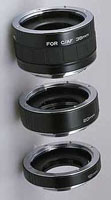 Again,
while not technically a lens, these Kenko Extension Tubes
can be used with any lenses to decrease their Minimum Focus Distance
(MFD). The Kenko set consists of 3 tubes (12 mm, 20 mm and 32
mm) which can be used individually, or in any combination. I've
used the full set in combination with the Canon 100/f2.8 macro
lens, and achieved about 2x magnification. There is some cost
in light (but no optical degradation, as there is no glass - just
hollow tubes with the appropriate electrical contacts). I also
use them with the 100-400, decreasing its MFD down to 3 or 4 feet,
especially for photographing butterflies.
Again,
while not technically a lens, these Kenko Extension Tubes
can be used with any lenses to decrease their Minimum Focus Distance
(MFD). The Kenko set consists of 3 tubes (12 mm, 20 mm and 32
mm) which can be used individually, or in any combination. I've
used the full set in combination with the Canon 100/f2.8 macro
lens, and achieved about 2x magnification. There is some cost
in light (but no optical degradation, as there is no glass - just
hollow tubes with the appropriate electrical contacts). I also
use them with the 100-400, decreasing its MFD down to 3 or 4 feet,
especially for photographing butterflies.
3.
Flash/Studio
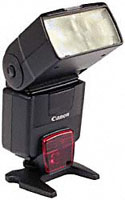 The
Canon 550EX flash is the flagship model of Canon's ETTL
series of flashes. It is a powerful unit that mates perfectly
with the 1D and D30. It has its own focus assist light (a striated
red color) that facilitates autofocus under relatively dim lighting
conditions. It can be combined with the Canon ST-E2, and other
550EX or 420EX flashes for a multiple flash, wireless system.
It can also be quite useful in outdoor photography, to "fill
in" harsh or undesireable shadows created by bright sunlight.
The
Canon 550EX flash is the flagship model of Canon's ETTL
series of flashes. It is a powerful unit that mates perfectly
with the 1D and D30. It has its own focus assist light (a striated
red color) that facilitates autofocus under relatively dim lighting
conditions. It can be combined with the Canon ST-E2, and other
550EX or 420EX flashes for a multiple flash, wireless system.
It can also be quite useful in outdoor photography, to "fill
in" harsh or undesireable shadows created by bright sunlight.
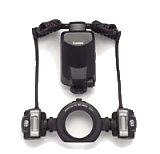 Acquired
in April, 2004, the Canon MT-24EX dual macro flash is an
extremely versatile unit, enabling very sophisticated control
in macro photography. Each flash head can be positioned and angled
independently, and the power ratio can also be adjusted as well.
Acquired
in April, 2004, the Canon MT-24EX dual macro flash is an
extremely versatile unit, enabling very sophisticated control
in macro photography. Each flash head can be positioned and angled
independently, and the power ratio can also be adjusted as well.
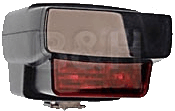 The
ST-E2 transmitter shown here allows infrared control of
up to 2 groups of compatible electronic flashes, such as the 550EX,
with the ability to adjust the relative output ratio between the
two flashes or groups of flashes. It also has an auto-focus assist
light which is much more effective than the one built into the
D30, and because of its red color, is much less distracting. This
has come in handy with macro and bird photography, with the flash
mounted on either the Combo2 or Sidekick brackets, and also with
Portrait work, where I have a pair of 550EX flashes mounted on
their own stands with umbrellas.
The
ST-E2 transmitter shown here allows infrared control of
up to 2 groups of compatible electronic flashes, such as the 550EX,
with the ability to adjust the relative output ratio between the
two flashes or groups of flashes. It also has an auto-focus assist
light which is much more effective than the one built into the
D30, and because of its red color, is much less distracting. This
has come in handy with macro and bird photography, with the flash
mounted on either the Combo2 or Sidekick brackets, and also with
Portrait work, where I have a pair of 550EX flashes mounted on
their own stands with umbrellas.
 This
is the "Combo2" flash bracket made by Wimberley. It attaches via the 'Arca-Swiss'
mechanism, and allows considerable flexibility in attaching a
flash to the camera, tripod, etc. I use this for getting the flash
closer to the subject in Macro work.
This
is the "Combo2" flash bracket made by Wimberley. It attaches via the 'Arca-Swiss'
mechanism, and allows considerable flexibility in attaching a
flash to the camera, tripod, etc. I use this for getting the flash
closer to the subject in Macro work.
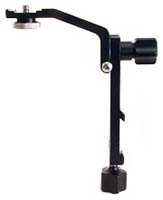 The
Sidekick Flash Bracket uses one of the same modules as the Combo2 bracket,
and I use it for mounting the 550EX above either the 100-400 or
600 telephoto lenses for fill-in flash wildlife photography. I
previously used the Combo2 unit for this purpose, which does work
fine, but it's just more cumbersome to set up and get aligned
properly with the telephoto lens. The Combo2 bracket is ideal
for macro work where you need flexibility in positioning the flash,
while the Sidekick Bracket is perfect for telephoto work, and
sets up much quicker.
The
Sidekick Flash Bracket uses one of the same modules as the Combo2 bracket,
and I use it for mounting the 550EX above either the 100-400 or
600 telephoto lenses for fill-in flash wildlife photography. I
previously used the Combo2 unit for this purpose, which does work
fine, but it's just more cumbersome to set up and get aligned
properly with the telephoto lens. The Combo2 bracket is ideal
for macro work where you need flexibility in positioning the flash,
while the Sidekick Bracket is perfect for telephoto work, and
sets up much quicker.
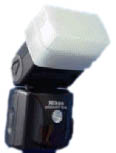 This
is the Stofen Omnibounce flash attachment. These come in
various sizes (and colors) to fit on a wide variety of flash units.
It's very helpful in diffusing electronic flash when it's not
feasible to set up off-camera flash. It reduces much of the harshness
(and eliminates 'red-eye') that typically accompanies on-camera
use of flash.
This
is the Stofen Omnibounce flash attachment. These come in
various sizes (and colors) to fit on a wide variety of flash units.
It's very helpful in diffusing electronic flash when it's not
feasible to set up off-camera flash. It reduces much of the harshness
(and eliminates 'red-eye') that typically accompanies on-camera
use of flash.
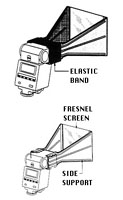 An
unusual accessory, the "Better
Beamer" is mounted on the flash, and through
the use of the Fresnel screen at the front, enables use of the
flash over much longer distances than usual. It can be effectively
used for "fill-in" flash, especially with bird photography.
I found out about this in the Avian section of the Nature Photographers
Network (NPN)
website, where there are some astonishingly great bird photographs.
An
unusual accessory, the "Better
Beamer" is mounted on the flash, and through
the use of the Fresnel screen at the front, enables use of the
flash over much longer distances than usual. It can be effectively
used for "fill-in" flash, especially with bird photography.
I found out about this in the Avian section of the Nature Photographers
Network (NPN)
website, where there are some astonishingly great bird photographs.
 This
is the "PeoplePopper" by Photek. It is a portable background system,
which I've used with the portrait work I've done with my family.
It's relatively inexpensive, light and portable, and they have
a large variety of background colors and patterns available. The
only downside is that the size of 6x7 feet limits you somewhat,
but for individuals, or small groups, it is quite effective.
This
is the "PeoplePopper" by Photek. It is a portable background system,
which I've used with the portrait work I've done with my family.
It's relatively inexpensive, light and portable, and they have
a large variety of background colors and patterns available. The
only downside is that the size of 6x7 feet limits you somewhat,
but for individuals, or small groups, it is quite effective.
4.
Other Accessories
 This
is the Gitzo 1329 tripod. It took me almost as much time
to settle on a tripod, as it did deciding on which lenses to get.
For better or worse, the options are almost endless. In the end,
I decided to go with the Gitzo 1329. The Carbon Fiber construction
minimizes weight while maximizing stability. It can be used with
or without the Center Column. It has 3 leg sections, verses 4,
so is a bit more stable, quicker/easier to set up, but is a little
longer when collapsed.
This
is the Gitzo 1329 tripod. It took me almost as much time
to settle on a tripod, as it did deciding on which lenses to get.
For better or worse, the options are almost endless. In the end,
I decided to go with the Gitzo 1329. The Carbon Fiber construction
minimizes weight while maximizing stability. It can be used with
or without the Center Column. It has 3 leg sections, verses 4,
so is a bit more stable, quicker/easier to set up, but is a little
longer when collapsed.
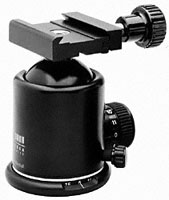 The
Arca-Swiss B-1 ballhead is considered to be one of the
best ballheads manufactured. It has exquisite control and stability,
including the ability to quickly flip into vertical orientation.
It has the Arca-Swiss quick release plate on top, and with adapters
for various cameras and lenses, allows for rapid and secure attachment.
The
Arca-Swiss B-1 ballhead is considered to be one of the
best ballheads manufactured. It has exquisite control and stability,
including the ability to quickly flip into vertical orientation.
It has the Arca-Swiss quick release plate on top, and with adapters
for various cameras and lenses, allows for rapid and secure attachment.
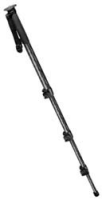 This
is the Bogen 3449 Carbon Fiber monopod. It's pretty light-weight,
extends quite high, and has 4 sections. I've used this most effectively
with my Canon 100-400L, in conjunction with the Arca-Swiss Ballhead
and Wimberley Sidekick, for butterfly and other work.
This
is the Bogen 3449 Carbon Fiber monopod. It's pretty light-weight,
extends quite high, and has 4 sections. I've used this most effectively
with my Canon 100-400L, in conjunction with the Arca-Swiss Ballhead
and Wimberley Sidekick, for butterfly and other work.
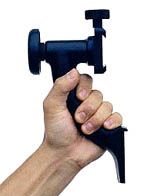 The
Wimberley "Sidekick"
shown here is used
to provide a "gimbal" type of mount when using a telephoto
such as the Canon 100-400L or 600L, on an Arca-Swiss type ballhead.
When set up and balanced, it makes maneuvering and following movement
dramatically easier and more stable, and has made a huge difference
with bird photography. I really can't imagine using a telephoto
on a tripod without it.
The
Wimberley "Sidekick"
shown here is used
to provide a "gimbal" type of mount when using a telephoto
such as the Canon 100-400L or 600L, on an Arca-Swiss type ballhead.
When set up and balanced, it makes maneuvering and following movement
dramatically easier and more stable, and has made a huge difference
with bird photography. I really can't imagine using a telephoto
on a tripod without it.
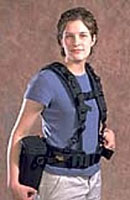 As
I considered how I was going to haul around all this gear in the
field, I received some advice to consider a system from a company
called KinesisGear. It is a modular case, belt and harness
system that can be easily customized to suit your particular gear
and needs. The model on the left shows a typical belt and harness
with a long lens case attached. This system has made it infinitely
more comfortable to carry whatever gear is needed, and have it
all readily accessible. I have bags for all of my lenses, and
even one for my tripod, which can be attached to the backpack.
Highly recommended. Further information can be found by clicking
on their logo:
As
I considered how I was going to haul around all this gear in the
field, I received some advice to consider a system from a company
called KinesisGear. It is a modular case, belt and harness
system that can be easily customized to suit your particular gear
and needs. The model on the left shows a typical belt and harness
with a long lens case attached. This system has made it infinitely
more comfortable to carry whatever gear is needed, and have it
all readily accessible. I have bags for all of my lenses, and
even one for my tripod, which can be attached to the backpack.
Highly recommended. Further information can be found by clicking
on their logo:
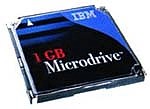 As with any digital camera, the
images are stored on some type of memory card. The 1D and D30
allows the use of Compact Flash Types I or II. I decided on the
1 gigabyte IBM MicroDrive (CF Type II) for the high capacity
and low cost/megabyte compared to regular CF Type I cards. It
is basically a tiny hard drive, and as such is potentially subject
to mechanical problems vs the no moving part solid state CF Type
I. With reasonable care, however, problems are rare. I was so
pleased with the first MD, that I added another one before my
trip to Florida.
As with any digital camera, the
images are stored on some type of memory card. The 1D and D30
allows the use of Compact Flash Types I or II. I decided on the
1 gigabyte IBM MicroDrive (CF Type II) for the high capacity
and low cost/megabyte compared to regular CF Type I cards. It
is basically a tiny hard drive, and as such is potentially subject
to mechanical problems vs the no moving part solid state CF Type
I. With reasonable care, however, problems are rare. I was so
pleased with the first MD, that I added another one before my
trip to Florida.
 Inkjet printers have developed to
the point where prints rivaling or exceeding that from traditional
photolabs can be purchased at reasonable prices (see here to go to my webpage about printing).
I'm currently using the Epson 1280, shown here. It can
print at 2880x720 dpi, is a 6-color printer, with 4 pico-liter
drop size, and can print "full-bleed" (meaning edge-to-edge
printing) on paper up to 13"x19" in size. The quality
has to be seen to be believed. You can click on the 1280 picture
here, and you'll be taken to Epson's site giving more specifications
on this printer.
Inkjet printers have developed to
the point where prints rivaling or exceeding that from traditional
photolabs can be purchased at reasonable prices (see here to go to my webpage about printing).
I'm currently using the Epson 1280, shown here. It can
print at 2880x720 dpi, is a 6-color printer, with 4 pico-liter
drop size, and can print "full-bleed" (meaning edge-to-edge
printing) on paper up to 13"x19" in size. The quality
has to be seen to be believed. You can click on the 1280 picture
here, and you'll be taken to Epson's site giving more specifications
on this printer.
Click
here to return to the Home Page
 After
almost 8 years of relying on my trusty Mark II, in April, 2012 I upgraded to the
Canon EOS 1D Mark IV. This camera represents a few
generations of improvements to just about all aspects of the camera: a 16.1
megapixel CMOS self-cleaning sensor with increased dynamic range, a much larger,
higher resolution LCD, much improved image quality at higher ISO, Continuous
Shooting Speed of 10 frames/second, with a buffer able to accommodate 26+ Raw
Images, HD Video capability, ability to accommodate higher speed and capacity CF
and SD cards, a new Lithium Ion battery system with superior performance, is
slightly lighter overall, with numerous other operational and performance
enhancements. Ironically, Canon is soon to come up with the 1D X, with a
full-frame sensor, a redesigned Autofocus system and other improvements.
But inexplicably they have apparently omitted the ability to use Autofocus with
a lens/teleconverter combination at f/8, which I rely on extensively.
Further, the pixel density is actually less than the Mark IV, which is a
significant disadvantage when using telephoto lenses and shooting small subjects
like birds. For these reasons, in addition to a huge step-up in price, the
Mark IV seems to meet my shooting needs better than the 1D X.
After
almost 8 years of relying on my trusty Mark II, in April, 2012 I upgraded to the
Canon EOS 1D Mark IV. This camera represents a few
generations of improvements to just about all aspects of the camera: a 16.1
megapixel CMOS self-cleaning sensor with increased dynamic range, a much larger,
higher resolution LCD, much improved image quality at higher ISO, Continuous
Shooting Speed of 10 frames/second, with a buffer able to accommodate 26+ Raw
Images, HD Video capability, ability to accommodate higher speed and capacity CF
and SD cards, a new Lithium Ion battery system with superior performance, is
slightly lighter overall, with numerous other operational and performance
enhancements. Ironically, Canon is soon to come up with the 1D X, with a
full-frame sensor, a redesigned Autofocus system and other improvements.
But inexplicably they have apparently omitted the ability to use Autofocus with
a lens/teleconverter combination at f/8, which I rely on extensively.
Further, the pixel density is actually less than the Mark IV, which is a
significant disadvantage when using telephoto lenses and shooting small subjects
like birds. For these reasons, in addition to a huge step-up in price, the
Mark IV seems to meet my shooting needs better than the 1D X. As
of May 2, 2004, I am shooting with the Canon EOS-1D Mark II.
It is based on the prior 1D, but with substantial improvements:
double the resolution (now 8.2 megapixels), it can shoot up to
20 Raw images (40 Jpeg), at 8.5 frames/second, in a single burst,
has even faster AutoFocus, an ISO range of 50-3200 with dramatically
improved image quality and very low noise at higher ISO, a significantly
improved flash system dubbed ETTL2, a brighter and higher
resolution LCD with zoom for image review, an orientation sensor
to automatically rotate vertical images, half the power consumption
resulting in double the battery life, and a number of other enhancements.
It is second in resolution only to the Canon EOS-1Ds (11.4 megapixels),
but is dramatically faster with superior high ISO performance.
For the type of photography I do, the 1D Mark II is the better
instrument, although if somebody wanted to donate a 1Ds for me
to use in addition for when speed wasn't an issue, I would be
happy to take it off their hands!
As
of May 2, 2004, I am shooting with the Canon EOS-1D Mark II.
It is based on the prior 1D, but with substantial improvements:
double the resolution (now 8.2 megapixels), it can shoot up to
20 Raw images (40 Jpeg), at 8.5 frames/second, in a single burst,
has even faster AutoFocus, an ISO range of 50-3200 with dramatically
improved image quality and very low noise at higher ISO, a significantly
improved flash system dubbed ETTL2, a brighter and higher
resolution LCD with zoom for image review, an orientation sensor
to automatically rotate vertical images, half the power consumption
resulting in double the battery life, and a number of other enhancements.
It is second in resolution only to the Canon EOS-1Ds (11.4 megapixels),
but is dramatically faster with superior high ISO performance.
For the type of photography I do, the 1D Mark II is the better
instrument, although if somebody wanted to donate a 1Ds for me
to use in addition for when speed wasn't an issue, I would be
happy to take it off their hands! This
was Canon's top of the line digital Single Lens Reflex camera
when it was introduced: the Canon EOS-1D. It was delivered
to my doorstep on April 25, 2002. It has a 4.15 megapixel CCD
sensor, with a 1.3x "multiplier." It has Canon's most
sophisticated autofocus, metering and white balance system, has
an ISO range from 100 to 3200, shutter speeds up to 1/16,000 second,
can shoot at 8 frames/second for up to 16 or 21 frames before
its buffer is filled, offers a wide variety of custom and personal
functions to individualize its operations, connects to a computer
via a Firewire cable, and is built like a tank. For more comprehensive
information on the 1D, go to
This
was Canon's top of the line digital Single Lens Reflex camera
when it was introduced: the Canon EOS-1D. It was delivered
to my doorstep on April 25, 2002. It has a 4.15 megapixel CCD
sensor, with a 1.3x "multiplier." It has Canon's most
sophisticated autofocus, metering and white balance system, has
an ISO range from 100 to 3200, shutter speeds up to 1/16,000 second,
can shoot at 8 frames/second for up to 16 or 21 frames before
its buffer is filled, offers a wide variety of custom and personal
functions to individualize its operations, connects to a computer
via a Firewire cable, and is built like a tank. For more comprehensive
information on the 1D, go to  The
introduction of the Canon D30 really changed the world
of digital photography, introducing a relatively low-cost digital
SLR with extremely high quality images. This was at least in part
attributable to its CMOS sensor (1.6x multiplier factor). It produces
3.1 megapixel images, and has an ISO range of 100 to 1600, and
shutter speeds up to 1/4000 second. It can shoot at 3 frames/second
for up to 6-8 shots. The main 'weakness' of the D30 was its autofocus
and metering systems. While these are generally quite a bit better
than any 'point and shoot' digital camera, and function well under
a wide variety of shooting circumstances, it wasn't the best that
Canon had to offer in this regard. This full potential was achieved
with the introduction of the Canon EOS-1D. For more information
on the D30, click
The
introduction of the Canon D30 really changed the world
of digital photography, introducing a relatively low-cost digital
SLR with extremely high quality images. This was at least in part
attributable to its CMOS sensor (1.6x multiplier factor). It produces
3.1 megapixel images, and has an ISO range of 100 to 1600, and
shutter speeds up to 1/4000 second. It can shoot at 3 frames/second
for up to 6-8 shots. The main 'weakness' of the D30 was its autofocus
and metering systems. While these are generally quite a bit better
than any 'point and shoot' digital camera, and function well under
a wide variety of shooting circumstances, it wasn't the best that
Canon had to offer in this regard. This full potential was achieved
with the introduction of the Canon EOS-1D. For more information
on the D30, click  Starting
at the wide angle, this lens is the Canon 15mm/f2.8 Fisheye.
It provides a 180 degree angle of view, which creates a unique
perspective that can come in handy at times. It has a minimum
focusing distance of 8" which can create some unusual close-up
shots.
Starting
at the wide angle, this lens is the Canon 15mm/f2.8 Fisheye.
It provides a 180 degree angle of view, which creates a unique
perspective that can come in handy at times. It has a minimum
focusing distance of 8" which can create some unusual close-up
shots. Next
is the Canon 17-35L/f2.8 zoom lens. It is shown here with
the Lens Hood attached. The L designation is for Canon's professional
line of lenses, and superior optics. The f/2.8 is a nice, constant
wide aperture throughout the zoom range, increasing shooting flexibility.
I used this lens quite a bit on my trip to Southern Utah and Northern
Arizona in May of 2001. Canon has recently come out with an updated
version of this lens, the 16-35L/f2.8.
Next
is the Canon 17-35L/f2.8 zoom lens. It is shown here with
the Lens Hood attached. The L designation is for Canon's professional
line of lenses, and superior optics. The f/2.8 is a nice, constant
wide aperture throughout the zoom range, increasing shooting flexibility.
I used this lens quite a bit on my trip to Southern Utah and Northern
Arizona in May of 2001. Canon has recently come out with an updated
version of this lens, the 16-35L/f2.8. This
is the Canon 50/f1.4. It's the 'fastest' lens I have, and
comes in handy when I want to shoot without flash in low light
conditions. It functions well as a portrait lens with either the
1D or D30, where their multiplier effects make this the equivalent
of a 65 mm or 80 mm lens, respectively. It is also known as a
very sharp lens, despite the fact that it's not an actual "L"
series lens.
This
is the Canon 50/f1.4. It's the 'fastest' lens I have, and
comes in handy when I want to shoot without flash in low light
conditions. It functions well as a portrait lens with either the
1D or D30, where their multiplier effects make this the equivalent
of a 65 mm or 80 mm lens, respectively. It is also known as a
very sharp lens, despite the fact that it's not an actual "L"
series lens. The
Canon 28-135/f3.5-5.6 IS lens is perhaps one of the best
single lens for general use with either the D30 or 1D. The focal
length covers a very wide and useful range, and while it's not
the fastest lens around, the Image Stabilization (IS) is quite
effective, giving you perhaps an extra stop or two to work with.
It is fairly small and light, and has decent macro capabilities
as well. If I'm wanting to do some casual shooting, and travel
as light as possible, this is the lens I'll take.
The
Canon 28-135/f3.5-5.6 IS lens is perhaps one of the best
single lens for general use with either the D30 or 1D. The focal
length covers a very wide and useful range, and while it's not
the fastest lens around, the Image Stabilization (IS) is quite
effective, giving you perhaps an extra stop or two to work with.
It is fairly small and light, and has decent macro capabilities
as well. If I'm wanting to do some casual shooting, and travel
as light as possible, this is the lens I'll take. The
Canon 28-70L/f2.8 is a fast, sharp lens, covering a reasonably
wide focal range, replacing the lower half of the coverage of
the 28-135. Though significantly heavier than the 28-135, it's
still not too much to use 'casually' and I've enjoyed using it
to photograph my grandchildren around the house.
The
Canon 28-70L/f2.8 is a fast, sharp lens, covering a reasonably
wide focal range, replacing the lower half of the coverage of
the 28-135. Though significantly heavier than the 28-135, it's
still not too much to use 'casually' and I've enjoyed using it
to photograph my grandchildren around the house. Covering
the longer end of the range of the 28-135 is a relatively new
lens, the Canon 70-200L/f2.8 IS. This is also a fast, sharp
lens, and very useful in low-light shooting - indoors, sports,
etc. My first outing with it was photographing a High School soccer
match, and as the sun set, I was very pleased with its autofocus
capability, and the ISO and shutter speed options it provided.
The IS is quite effective, gaining 2 to possibly 3 stops. it can
be used with the 1.4x or 2x teleconverters, further extending
its usefulness.
Covering
the longer end of the range of the 28-135 is a relatively new
lens, the Canon 70-200L/f2.8 IS. This is also a fast, sharp
lens, and very useful in low-light shooting - indoors, sports,
etc. My first outing with it was photographing a High School soccer
match, and as the sun set, I was very pleased with its autofocus
capability, and the ISO and shutter speed options it provided.
The IS is quite effective, gaining 2 to possibly 3 stops. it can
be used with the 1.4x or 2x teleconverters, further extending
its usefulness. Serving
as both a high quality macro lens, and a decent lens for portrait
and other types of photography, the Canon 100/f2.8 Macro. It
is considered to be one of Canon's sharpest lenses, and its macro
capability allows up to 1:1 magnification, without requiring the
use of any other accessories. At a relatively fast f/2.8, it can
be used effectively in low-light conditions, and it can stop down
to f/32, maximizing depth of field for macro shots.
Serving
as both a high quality macro lens, and a decent lens for portrait
and other types of photography, the Canon 100/f2.8 Macro. It
is considered to be one of Canon's sharpest lenses, and its macro
capability allows up to 1:1 magnification, without requiring the
use of any other accessories. At a relatively fast f/2.8, it can
be used effectively in low-light conditions, and it can stop down
to f/32, maximizing depth of field for macro shots. The
Canon 100-400L/f4.5-5.6 IS, shown here with the Lens Hood
and Tripod Collar, is a fantastic telephoto lens, covering a wide
focal range, and is extremely sharp. The IS is quite effective,
and I've used this lens quite a bit for much of my nature and
wildlife shooting. At a little over 3 pounds, it's a big lens
to haul around, but it's still not too big to hand-hold effectively.
The
Canon 100-400L/f4.5-5.6 IS, shown here with the Lens Hood
and Tripod Collar, is a fantastic telephoto lens, covering a wide
focal range, and is extremely sharp. The IS is quite effective,
and I've used this lens quite a bit for much of my nature and
wildlife shooting. At a little over 3 pounds, it's a big lens
to haul around, but it's still not too big to hand-hold effectively. This
is the famous Canon 600L/f4 IS, one of the Canon "big
guns." Weighing in at a little under 12 pounds, it makes
the 100-400 look and feel puny. It basically requires the use
of a tripod or monopod because of its weight, but it's reach,
speed, and sharpness are incomparable. It opens up new possibilities
in bird photography, and I've been having a blast with it.
This
is the famous Canon 600L/f4 IS, one of the Canon "big
guns." Weighing in at a little under 12 pounds, it makes
the 100-400 look and feel puny. It basically requires the use
of a tripod or monopod because of its weight, but it's reach,
speed, and sharpness are incomparable. It opens up new possibilities
in bird photography, and I've been having a blast with it. While
not a lens in its own right, the Canon 1.4x II Teleconverter
can be used to multiple the focal length of select telephoto lenses
(at the cost of 1 stop of light), but can be attached to any lens
with the use of a small extension tube. It changes the 100-400
lens to a 140-560 lens, and the 600 becomes an 840. There is a
little loss of optical quality, but this is generally fairly minimal.
While
not a lens in its own right, the Canon 1.4x II Teleconverter
can be used to multiple the focal length of select telephoto lenses
(at the cost of 1 stop of light), but can be attached to any lens
with the use of a small extension tube. It changes the 100-400
lens to a 140-560 lens, and the 600 becomes an 840. There is a
little loss of optical quality, but this is generally fairly minimal. This
is the Canon 2x II Teleconverter, which is used similarly
to the 1.4x. Thus the 600 lens becomes a 1200 lens, but at the
cost of 2 stops. Further, it can be "stacked" with the
1.4x, giving a 2.8x multiplication of focal length, so the 600
is now a 1680 mm super-telephoto! With loss of 3 stops of light,
and some optical degradation, shooting technique has to be extremely
careful and solid to yield useable results.
This
is the Canon 2x II Teleconverter, which is used similarly
to the 1.4x. Thus the 600 lens becomes a 1200 lens, but at the
cost of 2 stops. Further, it can be "stacked" with the
1.4x, giving a 2.8x multiplication of focal length, so the 600
is now a 1680 mm super-telephoto! With loss of 3 stops of light,
and some optical degradation, shooting technique has to be extremely
careful and solid to yield useable results. Again,
while not technically a lens, these Kenko Extension Tubes
can be used with any lenses to decrease their Minimum Focus Distance
(MFD). The Kenko set consists of 3 tubes (12 mm, 20 mm and 32
mm) which can be used individually, or in any combination. I've
used the full set in combination with the Canon 100/f2.8 macro
lens, and achieved about 2x magnification. There is some cost
in light (but no optical degradation, as there is no glass - just
hollow tubes with the appropriate electrical contacts). I also
use them with the 100-400, decreasing its MFD down to 3 or 4 feet,
especially for photographing butterflies.
Again,
while not technically a lens, these Kenko Extension Tubes
can be used with any lenses to decrease their Minimum Focus Distance
(MFD). The Kenko set consists of 3 tubes (12 mm, 20 mm and 32
mm) which can be used individually, or in any combination. I've
used the full set in combination with the Canon 100/f2.8 macro
lens, and achieved about 2x magnification. There is some cost
in light (but no optical degradation, as there is no glass - just
hollow tubes with the appropriate electrical contacts). I also
use them with the 100-400, decreasing its MFD down to 3 or 4 feet,
especially for photographing butterflies. The
Canon 550EX flash is the flagship model of Canon's ETTL
series of flashes. It is a powerful unit that mates perfectly
with the 1D and D30. It has its own focus assist light (a striated
red color) that facilitates autofocus under relatively dim lighting
conditions. It can be combined with the Canon ST-E2, and other
550EX or 420EX flashes for a multiple flash, wireless system.
It can also be quite useful in outdoor photography, to "fill
in" harsh or undesireable shadows created by bright sunlight.
The
Canon 550EX flash is the flagship model of Canon's ETTL
series of flashes. It is a powerful unit that mates perfectly
with the 1D and D30. It has its own focus assist light (a striated
red color) that facilitates autofocus under relatively dim lighting
conditions. It can be combined with the Canon ST-E2, and other
550EX or 420EX flashes for a multiple flash, wireless system.
It can also be quite useful in outdoor photography, to "fill
in" harsh or undesireable shadows created by bright sunlight. Acquired
in April, 2004, the Canon MT-24EX dual macro flash is an
extremely versatile unit, enabling very sophisticated control
in macro photography. Each flash head can be positioned and angled
independently, and the power ratio can also be adjusted as well.
Acquired
in April, 2004, the Canon MT-24EX dual macro flash is an
extremely versatile unit, enabling very sophisticated control
in macro photography. Each flash head can be positioned and angled
independently, and the power ratio can also be adjusted as well. The
ST-E2 transmitter shown here allows infrared control of
up to 2 groups of compatible electronic flashes, such as the 550EX,
with the ability to adjust the relative output ratio between the
two flashes or groups of flashes. It also has an auto-focus assist
light which is much more effective than the one built into the
D30, and because of its red color, is much less distracting. This
has come in handy with macro and bird photography, with the flash
mounted on either the Combo2 or Sidekick brackets, and also with
Portrait work, where I have a pair of 550EX flashes mounted on
their own stands with umbrellas.
The
ST-E2 transmitter shown here allows infrared control of
up to 2 groups of compatible electronic flashes, such as the 550EX,
with the ability to adjust the relative output ratio between the
two flashes or groups of flashes. It also has an auto-focus assist
light which is much more effective than the one built into the
D30, and because of its red color, is much less distracting. This
has come in handy with macro and bird photography, with the flash
mounted on either the Combo2 or Sidekick brackets, and also with
Portrait work, where I have a pair of 550EX flashes mounted on
their own stands with umbrellas. This
is the "
This
is the " The
The
 This
is the Stofen Omnibounce flash attachment. These come in
various sizes (and colors) to fit on a wide variety of flash units.
It's very helpful in diffusing electronic flash when it's not
feasible to set up off-camera flash. It reduces much of the harshness
(and eliminates 'red-eye') that typically accompanies on-camera
use of flash.
This
is the Stofen Omnibounce flash attachment. These come in
various sizes (and colors) to fit on a wide variety of flash units.
It's very helpful in diffusing electronic flash when it's not
feasible to set up off-camera flash. It reduces much of the harshness
(and eliminates 'red-eye') that typically accompanies on-camera
use of flash. An
unusual accessory, the "
An
unusual accessory, the " This
is the "PeoplePopper" by
This
is the "PeoplePopper" by  This
is the Gitzo 1329 tripod. It took me almost as much time
to settle on a tripod, as it did deciding on which lenses to get.
For better or worse, the options are almost endless. In the end,
I decided to go with the Gitzo 1329. The Carbon Fiber construction
minimizes weight while maximizing stability. It can be used with
or without the Center Column. It has 3 leg sections, verses 4,
so is a bit more stable, quicker/easier to set up, but is a little
longer when collapsed.
This
is the Gitzo 1329 tripod. It took me almost as much time
to settle on a tripod, as it did deciding on which lenses to get.
For better or worse, the options are almost endless. In the end,
I decided to go with the Gitzo 1329. The Carbon Fiber construction
minimizes weight while maximizing stability. It can be used with
or without the Center Column. It has 3 leg sections, verses 4,
so is a bit more stable, quicker/easier to set up, but is a little
longer when collapsed. The
Arca-Swiss B-1 ballhead is considered to be one of the
best ballheads manufactured. It has exquisite control and stability,
including the ability to quickly flip into vertical orientation.
It has the Arca-Swiss quick release plate on top, and with adapters
for various cameras and lenses, allows for rapid and secure attachment.
The
Arca-Swiss B-1 ballhead is considered to be one of the
best ballheads manufactured. It has exquisite control and stability,
including the ability to quickly flip into vertical orientation.
It has the Arca-Swiss quick release plate on top, and with adapters
for various cameras and lenses, allows for rapid and secure attachment. This
is the Bogen 3449 Carbon Fiber monopod. It's pretty light-weight,
extends quite high, and has 4 sections. I've used this most effectively
with my Canon 100-400L, in conjunction with the Arca-Swiss Ballhead
and Wimberley Sidekick, for butterfly and other work.
This
is the Bogen 3449 Carbon Fiber monopod. It's pretty light-weight,
extends quite high, and has 4 sections. I've used this most effectively
with my Canon 100-400L, in conjunction with the Arca-Swiss Ballhead
and Wimberley Sidekick, for butterfly and other work. The
Wimberley "
The
Wimberley " As
I considered how I was going to haul around all this gear in the
field, I received some advice to consider a system from a company
called KinesisGear. It is a modular case, belt and harness
system that can be easily customized to suit your particular gear
and needs. The model on the left shows a typical belt and harness
with a long lens case attached. This system has made it infinitely
more comfortable to carry whatever gear is needed, and have it
all readily accessible. I have bags for all of my lenses, and
even one for my tripod, which can be attached to the backpack.
Highly recommended. Further information can be found by clicking
on their logo:
As
I considered how I was going to haul around all this gear in the
field, I received some advice to consider a system from a company
called KinesisGear. It is a modular case, belt and harness
system that can be easily customized to suit your particular gear
and needs. The model on the left shows a typical belt and harness
with a long lens case attached. This system has made it infinitely
more comfortable to carry whatever gear is needed, and have it
all readily accessible. I have bags for all of my lenses, and
even one for my tripod, which can be attached to the backpack.
Highly recommended. Further information can be found by clicking
on their logo:

